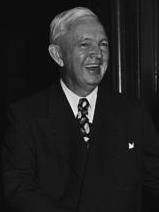Martin H. Kennelly | |
|---|---|
 Kennelly in 1949 | |
| 47th Mayor of Chicago | |
| In office April 15, 1947 – April 20, 1955 | |
| Preceded by | Edward Joseph Kelly |
| Succeeded by | Richard J. Daley |
| 10th President of the United States Conference of Mayors | |
| In office 1952–1953 | |
| Preceded by | David L. Lawrence |
| Succeeded by | Thomas A. Burke |
| Personal details | |
| Born | Martin Henry Kennelly August 11, 1887 Chicago, Illinois, U.S. |
| Died | November 29, 1961 (aged 74) Chicago, Illinois, U.S. |
| Resting place | Calvary Cemetery (Evanston, Illinois, U.S.) |
| Political party | Democratic |
| Alma mater | De La Salle Institute |
| Military service | |
| Allegiance | |
| Branch/service | |
| Rank | Captain |
| Battles/wars | World War I |
Martin Henry Kennelly (August 11, 1887 – November 29, 1961) was an American politician and businessman. He served as the 47th[1] Mayor of Chicago in Chicago, Illinois from April 15, 1947 until April 20, 1955. Kennelly was a member of the Democratic Party. According to biographer Peter O'Malley, he was chosen as mayor by a scandal-burdened Democratic machine that needed a reformer on top of the ticket. Kennelly was a wealthy businessman and civic leader, active in Irish and Catholic circles. As a long-time opponent of machine politics he accepted the nomination on condition the machine would not pressure him for patronage and that he did not have to play a leadership role in the party. This gave him a non-partisan image that satisfied the reform element.[2] As mayor he avoided partisanship and concentrated on building infrastructure and upgrading the city bureaucracy. He worked to extend civil service; he reorganized inefficient departments. The city took ownership of the mass transit system. He obtained federal aid for slum clearance and public housing projects and for new expressways construction.[2] At his death, Mayor Richard J. Daley, the party leader who defeated Kennelly in a bitter primary battle in 1955, called him, "a great Chicagoan who loved his city" and ordered City hall flags placed at half-mast.[3]
- ^ "Chicago Mayors". Chicago Public Library. Retrieved March 24, 2019.
- ^ a b O'Malley, (1980).
- ^ "Hold Rites Saturday for Martin Kennelly". Chicago Tribune. November 30, 1961. pp. 1, 16. Retrieved June 10, 2021 – via Newspapers.com.